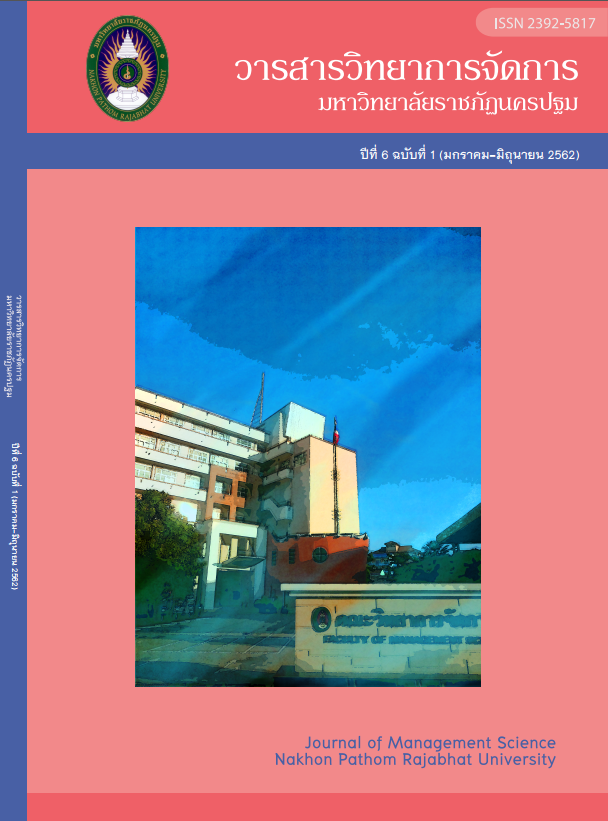Associations between Financial Strength and Accounting Methods.
Main Article Content
Abstract
This research studied the associations between accounting methods and financial strengths of the small and medium sized enterprises (SMEs) that registered in the Revenue Department’s ‘Single Set of Accounting Books’ Program in Nakhon Pathom Province. The researcher chose the research techniques to ensure that genuine data was provided, namely: the structured interview. The result of 342 structured interviews with the SMEs owners indicated that most of the SMEs adopted the methods that were easy to understand and to prepare. The financial strength of SMEs showed extremely different values. The statistical analysis at 0.05 level of confidence using Kruskal-Wallis H indicated these statistically significant associations: financial strength of liquidity had the most association with accounting methods, the firms using the average method of inventory valuation had higher financial strength than the firms using FiFo, the firms using the straight line method of depreciation calculation had higher financial strength than the firms using working-hour rate, the firms using the accrual basis for income realization had higher financial strength than the firms using the cash basis. The researcher suggested that the related government organizations should prepare an accounting computer application that provides choices for the right accounting methods that is opted for different types of SMEs to increases their financial strength and conformed to the regulations, not for only their convenience, and that a general employee of SMEs could do the data entry and financial report generating soon enough for the decision making of the owners. Suggestions for future research included the research that could improve the accounting computer application that provides right choices of accounting practices and more befitting to SMEs, and identify the direct effects of accounting methods on financial strengths.
Article history : Received 18 May 2018
Revised 1 September 2018
Accepted 5 September 2018
SIMILARITY INDEX = 0.00
Article Details
The views and opinions of the article appearing in this journal are those of the author. It is not considered a view and responsibility of the editorial staff.
References
กัญญาพัชญ์ อรุณรัตน์. (2557). ปัจจัยการเลือกใช้นโยบายการวัดมูลค่าสินค้าคงเหลือ ที่มีต่อฐานะการเงินและผลตอบแทนของบริษัทจดทะเบียนใน ตลาดหลักทรัพย์ เอ็ม เอ ไอ (MAI). วารสารวิชาการสมาคมสถาบันอุดมศึกษาเอกชนแห่งประเทศไทย (สสอท.), 20 (2), 69–78.
ขจรเกียรติ อรุณไพโรจนกุล. (2559). SME ได้อะไรมากกว่าเว้นภาษี ถ้าทำบัญชีเดียว. [ออนไลน์]. ค้นเมื่อ 6 พฤศจิกายน 2559 จาก https://www.efinancethai.com/MoneyStrategist/file/index.aspx?release=y&id=972&file_name=ms_20160218&symbol=MS.
ตลาดหลักทรัพย์แห่งประเทศไทย. (2556). คู่มือ SETSMART สูตรการคํานวณค่าสถิติและอัตราส่วนทางการเงิน. กรุงเทพ : ตลาดหลักทรัพย์แห่งประเทศไทย.
ตวงพรรณ มั่นศักดิ์ และ นิ่มนวล วิเศษสรรพ์. (2556). ความสัมพันธ์ระหว่างนโยบายการบัญชี การประมาณการทางบัญชีกับผลต่างภาษีเงินได้นิติบุคคล : กรณีบริษัทจดทะเบียนในตลาดหลักทรัพย์แห่งประเทศไทย. นำเสนอในการประชุมวิชาการมหาวิทยาลัยรังสิต ประจำปี 2556 (RSU Research Conference 2013).
ธัญญรัศม์ วศวรรณวัฒน์. (2558). นโยบายการบัญชีในการวัดมูลค่าสินค้าคงเหลือตามเกณฑ์ราคาทุนของบริษัทจดทะเบียนในตลาดหลักทรัพย์แห่งประเทศไทย. กรุงเทพ: มหาวิทยาลัยสุโขทัยธรรมาธิราช.
ภัทรธร ช่อวิชิต. (2557). ค่าเสื่อมราคาวิธีเส้นตรงและวิธีจำนวนปีต่างกันอย่างไร. [ออนไลน์]. ค้นเมื่อ 28 พฤษภาคม 2560 จาก https://www.investidea.in.th/2014/01/blog-post_12.html.
มณฑา เอมสวัสดิ์. (2552). ผลกระทบของวิธีการตีราคาสินค้าคงเหลือตามราคาทุน ที่มีต่อปัจจัยบ่งชี้ความเสี่ยงจากภาวะล้มละลายของบริษัทจดทะเบียนในตลาดหลักทรัพย์แห่งประเทศไทย: เปรียบเทียบระหว่างวิธีเข้าก่อน-ออกก่อนและวิธีถัวเฉลี่ยถ่วงน้ำหนัก. กรุงเทพ : วิทยาลัยราชพฤกษ์.
วรรษมน ทองรักษ์. (2554). ปัจจัยที่มีความสัมพันธ์กับความน่าเชื่อถือของงบการเงินของธุรกิจขนาดกลางและขนาดย่อม (SMEs) ในมุมมองนักวิเคราะห์สินเชื่อ. วิทยานิพนธ์บัญชีมหาบัณฑิต สาขาการบัญชี. มหาวิทยาลัยธรรมศาสตร์.
สภาวิชาชีพบัญชี ในพระบรมราชูปถัมภ์. (2560). มาตรฐานรายงานทางการเงิน. [ออนไลน์]. ค้นเมื่อ 14 กุมภาพันธ์ 2560 จาก https://www.fap.or.th/index.php?lay=show&ac=article&Id=539863468&Ntype=58.
สำนักปลัดกระทรวงการคลัง กลุ่มสารนิเทศการคลัง. (2559). มาตรการบัญชีเล่มเดียวและการยกเว้นและลดอัตราภาษีเงินได้นิติบุคคลสําหรับ SMEs. ข่าวกระทรวงการคลัง, 1(2559), 1.
อมรา ติรศรีวัฒน์. (2555). ปัญหาของสารสนเทศทางการบัญชีที่เป็นอุปสรรคต่อการให้สินเชื่อแก่วิสาหกิจขนาดกลางและขนาดย่อม. วารสารวิชาการสมาคมสถาบันอุดมศึกษาเอกชนแห่งประเทศไทย (สสอท.), 8 (2), 186–197.
Al-nassan, M. zuhair, Al-shaqnobi, M., & Nabaheen, M. (2013). Methods of Inventory Valuation Application and Limitation. Gaza: Islamic University of Gaza.
Analoui, F., & Karami, A. (2003). Strategic Management in Small and Medium Enterprises. Boston, MA: Thomson Learning.
Australian Bureau of Statistics. (2016). Sample Size Calculator. Retrieved June 17, 2016, from https://www.nss.gov.au/nss/home.nsf/NSS/0A4A642C712719DCCA2571AB00243 DC6?opendocument.
Beckert, P. J. (2007). Measuring Business Financial Strength. Retrieved April 25, 2017, from https://www.pinnaclebusiness.com/newsletter/Financial%20Review%20By%20Pinnacle%20Consultants%20042611.htm.
Covington, P. (2008). Success in Sociology: AS Student Book AQA. Buckinghamshire: Folens Limited.
European Commission. (2016, May 12). What is an SME? - European Commission. Retrieved May 22, 2016, from https://ec.europa.eu/growth/smes/business-friendly-environment/sme-definition/index_en.htm.
Garman, E. T., & Forgue, R. (2011). Personal Finance. Cengage Learning.
Greuning, H. van, & Koen, M. (2001). International Accounting Standards : A Practical Guide (6th ed.). Washington, D.C.: World Bank Publications.
Hair, J. F., Black, W. C., Babin, D. J., Anderson, R. E., & Tatham, R. L. (2006). Multivariate Data Analysis. (6th ed.). Saddle River: Prentice-Hall.
Jackson, S. B. (2008). The Effect of Firms’ Depreciation Method Choice on Managers’ Capital Investment Decisions. The Accounting Review, 83 (2), 315–376.
Lee, C. F., Lee, J. C., & Lee, A. C. (2000). Statistics for Business and Financial Economics (2nd ed.). Singapore: World Scientific.
Minority Business Development Agency. (2010). Financial Strength and Ratio Analysis. Retrieved April 25, 2017, from https://www.mbda.gov/news/blog/2010/08/financial-strength-and-ratio-analysis.
Newby, R., Watson, J., & Woodliff, D. (2003). SME survey methodology: response rates, data quality, and cost effectiveness. Entrepreneurship Theory and Practice, 28(2), 163–172.
Nisha, Nabila. (2015). Inventory Valuation Practices: A Developing Country Perspective. International Journal of Information Research and Review, 2 (7), 867-874.
Nobes, C. (2011). International Variations in IFRS Adoption and Practice. London: The Association of Chartered Certified Accountants.
Rao, P. M. (2012). Fundamentals of Accounting for CPT. New Delhi : PHI Learning.
Sahaf, M. A. (2013). Management Accounting: Principles & Practice. (3rd ed.). New Delhi: Vikas Publishing House.
US National Renewable Energy Laboratory. (2018). Mail Questionnaire Surveys. Retrieved April 6, 2018, from https://ump.pnnl.gov/showthread.php/5009-5.4.3-Mail-Questionnaire-Surveys.


